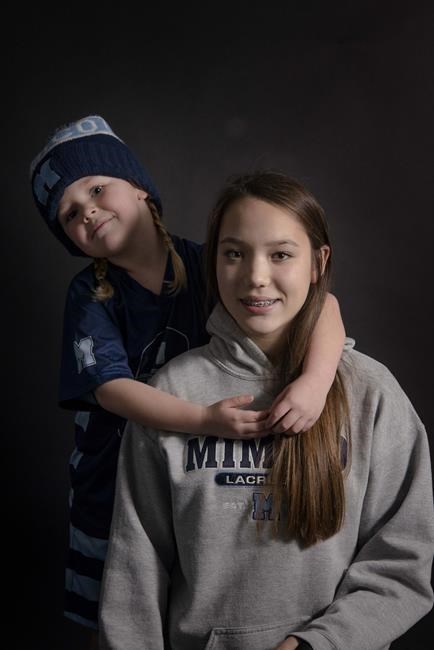TORONTO — Some 70 girls registered for the Mimico Lacrosse club's Mini Mountaineers this year.
It's a free program designed to teach young girls to love being active and an athlete first, and a lacrosse player second. The program in west Toronto sold out in less than two days. But like countless sports programs across Canada, the Mini Mountaineers were shelved for the year due to COVID-19.
"We're pretty disappointed that we didn't get a chance to carry it out," said Colleen Grimes, who along with a friend, started the first-ever Mountaineers girls team a decade ago. They still delivered free sticks to all the girls registered, and did a few Zoom sessions to demonstrate how to practise at home.
"But it's not the same as the in-person relationships that we were hoping to build, but hopefully in 2021 we'll be able to to build on that again."
Girls were already at a disadvantage within Canada's sports system, according to the Rally Report, released in June by Canadian Women & Sport.
The concern is that the global pandemic will only widen the gap.
Sunday was International Day of the Girl, and Canadian Women & Sport launched a national awareness campaign called "She's Got it All." As sports programs look to return to play, the campaign is about understanding the needs of female athletes and the support required to keep them in sport.
"Girls are already participating and benefiting from sport at much lower levels than boys particularly in adolescence," said Allison Sandmeyer-Graves, Canadian Women & Sport's CEO.
The Rally Report, conducted in partnership with Canadian Tire Jumpstart Charities, was the national study in four years on sport participation for girls aged six to 18.
The results were bleak. Participation levels for Canadian girls are much lower than boys, and there is a dramatic dropout rate with one in three girls leaving sport by late adolescence, a number that seen only a negligible improvement since a 2016 study.
By comparison, the dropout rate for boys aged 16-18 is only one in 10. At this rate, Canada won't see parity between girls and boys for at least the next 15 years.
The pandemic adds another layer of inequity, Sandmeyer-Graves said.
"(Girls) are not as well-supported already going into the pandemic," she said. "So when resources suddenly became way more scarce, and all these organizations, whether it's ice time, or budget, or media spots, or what have you, when those resources suddenly shrank dramatically, and organizations had to decide where they were going to allocate those resources, again, girls are at a disadvantage.
"Our concern is as the availability of resources goes down, opportunities will go down, and the rates will drop even further from where they are right now."
The campaign targets the unique challenges female athletes face. One poster of a female hockey goalie says: "She's got it all: Focus, talent, and equipment the boys don't want anymore."
Among the barriers found to affect girls' continuation in sport were low confidence, negative body image, perceived lack of skill, poor perceptions of belonging and feeling unwelcome.
"What we are using this campaign to do is draw people's attention to the fact that girls are experiencing sport often differently than boys, they are confronting things that are quite unique," Sandmeyer-Graves said. "And if we're not being really intentional in designing for girls, then we're not going to be as effective in serving them, and in keeping them engaged."
When Grimes, who grew up with four brothers who played lacrosse, started the first-ever Mimico girls team 10 years ago of players aged seven to 10, she said it was important the girls program received equal treatment from the outset.
"Because it just is true, like people do view women's sports as secondary to men's. It's just something that exists," she said.
She wanted the same branding as the boy's side of the 130-year-old lacrosse club. They would be called the Mountaineers, not the Lady Mountaineers. They weren't going to wear pink jerseys. She cringes when she hears female players refer to themselves as "chicks with sticks."
"The girls sports have a tendency to pink wash everything, especially at the younger age groups," Grimes said. "It's really important for the girls to recognize themselves in our community, and not feel like they're different."
Grimes' biggest fears is losing the resources to keep girls in their program, which now includes teams at every age group including adult. The club relied on small business support for the Mini Mountaineers free program, but those businesses are struggling just to stay afloat now amid the pandemic.
To kick off the campaign, Canadian Women & Sport offered some advice to support female athletes. To coaches, they suggest prioritizing social connections over comparisons and competition among teammates.
It's important for parents to expose their daughters to positive role models.
Sport organizations should increase the representation of women in leadership roles, including coaches and officials.
Canadian Women & Sport encourage allies to speak up about equitable access to programs, facilities,
And the media can make a commitment to increase representation of diverse media both in the content and behind the scenes.
The numbers of older girls and women have fallen in the past few decades according to the Rally Report. In 1992, just over half of women aged 15 or older were participating in sport. That dropped to 35 per cent by 2010. Only 18 per cent of women age 16–63 are currently involved in sport.
This report by The Canadian Press was first published Oct. 11, 2020.
Lori Ewing, The Canadian Press


